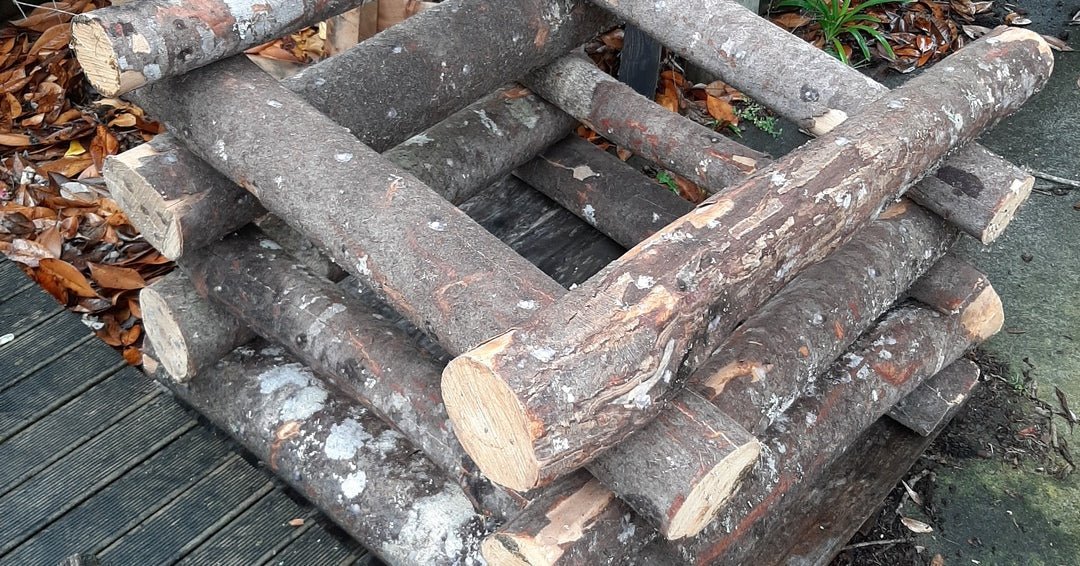How to Grow Mushrooms on Logs in Aotearoa New Zealand
Species Covered: Pleurotus pulmonarius (Phoenix Oyster), Hericium novae-zealandiae(Pekepeke-kiore), Cyclocybe parasitica (Tawaka)
This guide outlines techniques for cultivating three edible fungi on hardwood logs using outdoor methods adapted to New Zealand’s environment.
1. Choosing the Right Mushroom
| Common Name | Scientific Name | Māori Name | Characteristics |
|---|---|---|---|
| Phoenix Oyster | Pleurotus pulmonarius | — | Fast-growing, adaptable, beginner-friendly |
| Pekepekekiore | Hericium novae-zealandiae | Pekepeke-kiore | Coral-shaped, slow-growing, native, delicate in flavor and form |
| Tawaka | Cyclocybe parasitica | Tawaka | Native, robust and meaty, thrives on dying wood |
Each species has distinct habitat preferences and colonization behavior. Oyster mushrooms are versatile and forgiving. Pekepekekiore and Tawaka are slower, but valued for native biodiversity and culinary quality.
2. Selecting Logs
Type: Use non-aromatic hardwoods such as poplar, birch, oak, beech, or native species like tawa and mahoe.
Size: 10–15 cm diameter, 30–100 cm length
Age: Ideally cut 2–6 weeks prior. Bark must be intact and wood free of rot or mold.
Species Preferences:
Phoenix Oyster: Accepts a wide range of hardwoods.
Tawaka: Prefers upright orientation on standing deadwood or large-diameter horizontal logs.
Pekepekekiore: Performs best on dense, slow-decaying wood like beech.
3. Inoculation Method
Tools Required:
Inoculated wooden dowels (spawn)
Drill with 8–9 mm bit
Hammer or mallet
Melted soy wax or beeswax
Labeling tape or tags
Steps:
- Drill holes 5–7 cm deep in a diamond pattern around the log, spaced 15–20 cm apart.
- Insert dowels and tap flush with the bark surface.
- Seal with melted wax to prevent contamination and moisture loss.
- Label logs with species and inoculation date.
Alternative: For large-scale operations, sawdust spawn and a plunger-style inoculator may be used.
4. Placement and Maintenance
Environment: Choose shaded, wind-protected locations with natural humidity (e.g., under trees or beside buildings).
Stacking:
Horizontal crib stacks for Pleurotus and Hericium.
Upright leaning logs or partially buried base for Tawaka.
Moisture: Keep logs damp but not soaked. Water weekly in dry periods or soak logs every 6–8 weeks in summer.
Colonization Timeframes:
Pleurotus pulmonarius: 6–9 months.
Hericium coralloides: 9–15 months.
Cyclocybe parasitica: 12–18 months.
Avoid full sun, and keep logs elevated to reduce slug and pest access.
5. Fruiting and Harvest
| Species | Fruiting Season | Appearance | Harvest Method |
|---|---|---|---|
| Phoenix Oyster | Autumn and Spring | Clusters of white to grey caps from holes and ends | Twist and pull gently |
| Pekepekekiore | Autumn to early Winter | White coral-like branches from log cracks and ends | Cut at base to preserve mycelium |
| Tawaka | Late Summer to Autumn | Brown, meaty gilled mushrooms from dying wood | Harvest mature caps individually |
Logs can fruit seasonally for 3–5 years depending on wood type, moisture, and species.
6. Culinary and Cultural Notes
Phoenix Oyster: Common in stir-fries, soups, and grills. High yield and neutral flavor.
Pekepekekiore: Valued in Māori rongoā and cuisine for its soft texture and mild taste.
Tawaka: Dense texture and umami flavor. Cooked traditionally by pan-frying or roasting.
Tawaka and Pekepekekiore are both native to Aotearoa and contribute to biodiversity conservation efforts when cultivated responsibly.

